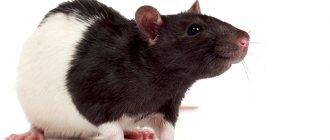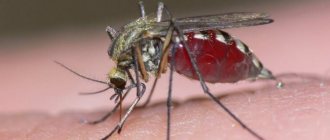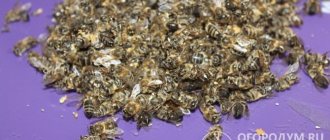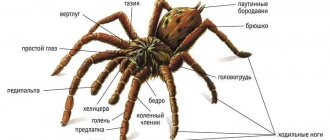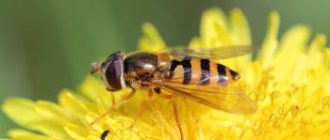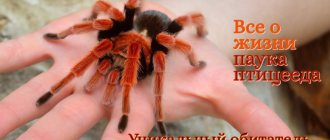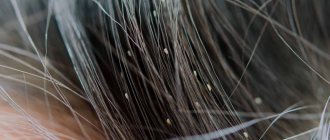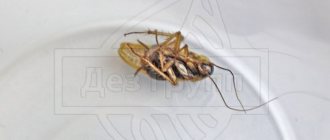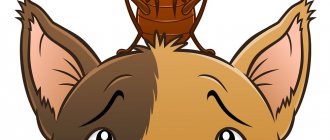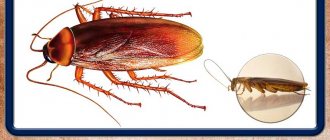What they look like
Entomologists know very well what hornets look like and will not confuse them with other insects.
The large wasp differs from other members of the family in the following characteristics:
- The head is larger, with a wide upper part. These Hymenoptera have 2 compound eyes and 3 simple ocelli.
- The head color varies between black, yellowish, orange or reddish brown interspersed with yellow spots. There are black-brown antennae on the head. The number of segments differs in females and males. The color of the jaw is black, brown or orange-yellow.
- The abdomen is rounded. In the area of its articulation with the chest, a beautiful thin waist line is visualized. In its color palette it resembles the common wasp, but the stripes are not so pronounced.
- At the end of the abdomen of working females and the uterus there is an ovipositor, which is a sting. If the insect manages to live calmly, then the sting is retracted into the abdomen and is not visualized. At its base there is a poisonous gland filled with a toxic substance. The sting is straight, smooth and has no jagged edges. A hornet can live with a used sting for a long time.
- Set of lower limbs - 3 pairs of legs, black, brown or yellow. Each limb includes a coxa, an acetabular ring, a proximal part, a tibia ending in a spur, and a tarsus.
The insect's wings are transparent with large cells . They are presented in 2 pairs: the front ones are large, the rear ones are small. While the hornet manages to live quietly, its front wings are connected together along the back.
During flight, the leading edge of the small wings is attached to the trailing edge of the large ones using special hooks. As a result, both right and both left wings create one aircraft.
Lifestyle of the giant scolia
The giant Scolia is a representative of the order Hymenoptera. Its fundamental difference from other wasps is its solitary lifestyle. The insect also has purely external distinctive features: black color, yellow plaques on the abdomen, strong wings, rough legs covered in coarse hairs, a large head, short and silent flight.
This huge wasp develops in a traditional life cycle: egg, larva, pupa, adult. Preparations for laying eggs begin in late summer. First of all, the fertilized female digs a hole somewhere near the habitat of future prey, which are the larvae of insects of certain species: rhinoceros beetle, bronze beetle, and beetle. The purpose of the scolius when biting is to immobilize its victim, neutralizing its nervous system with the help of a sting, and deliver it alive to its burrow.
Then oviposition occurs - right on the body of the prey. Each future larva requires a personal burrow and its own victim. Having completed her task and climbed out, the female covers the entrances to the burrows with earth. Further development of the offspring occurs without her participation.
The larva begins to feed, destroying the least important organs first. The last to be destroyed are the victim’s circulatory and nervous systems. The duration of this stage is about 12 days. Larval development includes three molts. Having successfully destroyed all the insides of its victim, the larva prepares a cocoon directly in the shell of the eaten insect. This takes about a day.
The cocoon shell is formed with the help of the salivary glands, which produce a special silk thread. The next stage is the formation of the pupa. This happens within 1 month. By mid-spring, an adult Scolia gigantea comes into the world. The male Scolia is always significantly smaller than the female (32 mm versus 55 mm for the female).
The giant scolius bites humans only in self-defense. Unlike many of their relatives, scolia do not know how to transmit signals and do not attack in swarms. The wasp prefers to use its sting for its intended purpose - to neutralize insects caught for raising larvae. The venom of this giant wasp is much less toxic compared to other wasps and bees.
Since Scolia larvae infect the offspring of insect pests, and adult individuals pollinate plants, feeding on nectar and pollen, these wasps are rightfully classified as beneficial. They are even sometimes specially imported to protect sugar cane plantations, orchards, vineyards, and coconut palms.
Giant Scolia
What do they eat?
What hornets eat is the following::
- sugary plant juice;
- juice of ripe soft fruits (peach, pear, apple);
- berries (raspberries, blackberries, strawberries);
- sugary secretions from aphids;
- bee products.
These insects are excellent hunters. Their victims include grasshoppers, spiders, and dragonflies. They can also live by feeding on flies, small locusts, caterpillars and close relatives - bees.
Prey is killed with powerful jaws and stings, then moistened with saliva and chewed to form a slurry. But the adult does not swallow this portion of food; she feeds it to the hungry larvae during their dynamic growth.
In 24 hours, a large colony of Hymenoptera feeds its larvae up to 500 g of processed other insects. Some hornets, in addition to catching live prey, also constantly search for dead insects. To live, they do not disdain fish or meat, which people throw away as waste. They actively feed their offspring with all this.
Relationship with a person
Of course, the hornet is a dangerous insect that poses a threat to human life and health. A bee sting and a wasp sting are different in nature. They have different chemical compositions and are treated differently.
The bite of such a large wasp as a hornet can pose a serious threat to humans. The fact is that the larger the wasp, the greater the amount of poison it can inject into the sting site at a time. Moreover, wasps do not tend to lose their sting in the wound, as happens in bees.
They can inflict several painful injections, and even a person who does not have an increased allergic reaction may experience serious problems with well-being and health after several bites from an insect of this size.
This is especially true for a species such as the Asian giant hornet, which is considered by entomologists to be one of the most dangerous arthropods on the planet.
Such a huge insect can inject enough venom to cause anaphylactic shock. And here you will have to call an ambulance.
We must remember that the importance of these stingers for gardening is very great. Whenever possible, people destroy colonies of these dangerous creatures sleeping in winter and poison them in the yard, but this is an extreme necessary measure. You just need to follow the rules of coexistence, because these large wasps themselves avoid contact with humans.
You should not touch a hornet's nest under any circumstances, even if you find it in your attic at home. It’s better to call specialists who will do everything right. If a large wasp is circling near you, do not wave your arms or make sudden movements, this will only anger the insect and cause aggression.
OUR READERS RECOMMEND!
To get rid of insects, our readers recommend the Pest-Reject repeller
. The operation of the device is based on the technology of electromagnetic pulses and ultrasonic waves! Absolutely safe, environmentally friendly product for humans and pets. Read more here...
Kinds
In addition to the common one, the following varieties of hornets are found::
- Deplorable. Endemic to the Philippine Islands. The color is brown or black, with white stripes visible on the wide abdomen. The clypeus is orange-yellow. This insect produces highly toxic poison, so its bite is very dangerous for humans or animals.
- Oriental. The body is red-brown in color, with a wide yellow-white stripe on the abdomen. It contains the pigment xanthopterin, which allows insects to convert absorbed sunlight into electricity. This type of insect is able to live in dry and hot climates.
- Black. The abdomen and chest are black-brown, the wings are brownish. This species is listed in the Red Book of the Chita Region. The insect almost never builds its own nests, parasitizing in the nests of hornets of other species.
One of the largest is the Japanese hornet . In the land of the rising sun it is often called the “sparrow-bee.” This is a very large insect, the body length of which is 4 cm, and the wingspan reaches 6 cm. Its large head is yellow in color. The abdomen is dark brown with yellow stripes.
The sting of the Japanese hornet wasp reaches a length of 6.2 mm. An insect bite is very painful. The poison contains nerve toxins. According to statistics, about 40 people die every year from attacks by such a hornet in Japan.
A giant among wasps - the Asian hornet
The largest wasp is Vespa mandarinia, also known as the Asian hornet. It should not be surprising that the title went to the hornet. This insect is a representative of the family of True wasps. Lives in the Middle Kingdom, Japan, Korea. Numerous populations occur in the Primorsky Krai in Russia.
Appearance
The largest wasp in the world reaches 5.9 cm in length, and the wingspan is 7.5 cm. If you sit such an individual on the palm of your hand, the wings will completely cover its surface. It is not for nothing that nature has awarded this species with its impressive size.
What does an insect look like:
- body color varies from rich yellow tones to moderate brown with characteristic black wide stripes and is determined by the subspecies;
- yellow head;
- cephalothorax in black tones;
- on both sides of the head there are huge teardrop-shaped eyes of almost black color;
- In the center of the forehead in the form of a triangle there are 3 additional simple eyes that allow you to distinguish between dark and light tones and help you navigate in space.
Lifestyle
Giant wasps live mainly in forests near bodies of water. The queen hornet is in charge of arranging the new nest, which is typical for all insects of this order. After waking up in the spring, she begins preparing a home for her future family. The female prepares building materials from chewed tree bark, abundantly moistened with saliva. She builds cells from a sticky substance in a very interesting way: she grabs the substrate with her front jaws, presses it tightly to her chest and, biting off a small piece, sticks it.
While the queen maintains her status as a “single mother,” she has to independently prepare food for the larvae. To do this, she is forced to hunt insects and deliver food to the cells. As soon as the working individuals emerge from the first eggs, the queen relinquishes all authority to arrange housing, prepare food, and is only concerned with the reproduction of offspring.
From morning to night, working hornets obtain food for the voracious larvae, whose diet must be enriched with protein foods. Therefore, giant wasps often raid apiaries and can completely destroy an entire family.
Killer wasps absorb honey, and the killed individuals are taken to the nest to feed the babies. It is worth noting that insects use their giant stings in extreme cases. They effortlessly cope with weak opponents using their developed jaws. It is difficult for beekeepers to resist the powerful force of wasp aggressors, so when they discover a hornet nest, they try to destroy it immediately.
Closer to autumn, population growth stops. The males die off after mating, and the fertilized queen looks for a new wintering place to start a new family next year.
How dangerous are giant wasps for humans?
Careless and ignorant tourists, having seen the largest wasp in the world, try to photograph it. The insect perceives this as aggression and attacks the person. There is no need to worry about the life of the wasp - in a split second it will remove its sting and go on about its business.
The following symptoms may appear:
- the appearance of redness, extensive swelling;
- changes in blood pressure;
- cardiopalmus;
- headache;
- cramp, severe pain in the affected area.
First aid for a victim of an Asian hornet before the doctor arrives is to remove the sting if it is accidentally left, disinfect the affected area and apply a cold compress to relieve pain, burning and reduce swelling.
Reproduction
With the arrival of warm days, the female hornet is actively looking for a place to lay eggs. She is ready to live and start a family only in suitable conditions, so in her search she flies over large areas. Having found a convenient corner, she immediately begins to create her home.
Each egg has its own sector. After 2-3 days, small hornet larvae hatch from them. They chew the lid and climb out. The offspring are born long before the winter period, manage to get stronger and continue the work that was started by the uterus.
After fertilization, the males die, followed by the old queen, and after some time the unfertilized individuals lose their lives. Those who have been fertilized overwinter, continue to live and then create their own nest. In the hornet family, reproduction is successful.
This is possible because the colonies are well organized. Everything happens harmoniously, thanks to the division of responsibilities. Some feed, build nests, while other members of the family raise offspring.
Characteristics of the hornet
The largest representative of social wasps from the order Hymenoptera, distributed in the northern hemisphere. The insect has a wasp-like waist and transparent wings. The abdomen is striped, the eyes are large, and the mouthparts are equipped with strong jaws. The largest wasp in the world differs from its smaller relatives by a richer range of colors: black, brown, orange and yellow colors are present on the body of this bright predator.
These insects create colonies and build dwellings consisting of honeycombs, which are arranged horizontally in several rows (up to 7 tiers). The material for building the nest is wood, which is exposed to saliva during the process of thorough chewing. These wasps choose places to live in the hollows of large trees, in attics and under the roof. In steppe regions, hornets prefer to build homes in the burrows of forest animals.
The hornet can feed on both plant foods and various insects. Among vegetarian foods, he prefers flower nectar, as well as ripe sweet fruits, honey and berries. However, it is a predator that feeds its larvae with prey. Among its victims are flies, gadflies, horseflies, wasps, locusts, and bees. The hornet thoroughly chews its prey and then feeds it with the resulting mass of its larvae.
The founder and head of the colony is the queen - the queen. After wintering, she awakens from hibernation and searches for a suitable place to establish a home. In the first row of honeycombs, she lays eggs and raises larvae, which at the beginning of summer already become workers (females who are not able to reproduce).
Worker hornets bring food for the next batch of larvae and for the queen, protect the nest from potential enemies and continue to build it. The queen is now exclusively occupied with laying eggs. In the autumn, young queens and drones also grow up in the aspen family. After mating at the end of autumn, they hide for the winter, and the old queen dies.
Building a nest
The place for the hornets' nest must be protected from bad weather and drafts. In nature, hornets often build nests in tree hollows. If their number decreases, then the queen begins to look for a home closer to the person.
Sometimes they choose birdhouses, fill them completely with tiers of honeycombs and go on new searches. Sometimes hornets hang a nest on tree branches, hide it in rocks, holes or in the attics of human houses.
To make a nest, hornets use a material resembling cardboard . When expanding the structure, they lead tiers (5-7 pieces) from top to bottom. Each honeycomb plate has up to 500 cells. When viewed from the outside, the nest resembles a cocoon. The shape changes at different stages of construction. The protective walls reach 2-3 cm. The most common color of cocoons is brown.
Where does the sea wasp live?
Photo: Australian sea wasp
The transparent predator inhabits coastal waters off the coast of northern Australia (from Gladstone in the east to Exmouth in the west), New Guinea and the islands of Indonesia, spreading north to the coasts of Vietnam and the Philippines.
Typically, these jellyfish do not swim into inland waters and prefer ocean space, although they stay shallow - in a layer of water up to 5 m deep and not far from the shore. They choose areas with a clean, usually sandy bottom and avoid algae thickets where their fishing gear can get tangled.
Such places are no less attractive to swimmers, surfers and scuba diving enthusiasts, which leads to clashes and casualties on both sides. Only during storms do jellyfish move away from the shore to deep and calm places to avoid getting caught in the surf.
To breed, sea wasps enter fresher river mouths and bays with mangroves. Here they spend their lives in the polyp stage, attached to underwater rocks. But having reached the jellyfish stage, young wasps again rush into the open ocean.
Now you know where the sea wasp is found. Let's see what the poisonous jellyfish eats.
Role in nature
Entomologists explain why the hornet is needed in nature. They are predators and destroy harmful insects and their larvae. Hornets play a regulatory role in wildlife. If they are completely destroyed, this will affect the balance of the ecosystem.
On the other hand, these predators harm beekeepers by eating bees. In addition, they damage fruits, reducing yields. If a person comes close to hornet nests, they may attack. These insects sting very painfully, causing allergic reactions and inflammation.
The benefits and harms of insects
Hornets bring undoubted benefits, participating, like all other living beings, in food chains, occupying a certain place in nature. In particular, they destroy forest and garden pests, such as aphids.
In Germany, Austria, as well as in other countries, European hornets have been protected since January 1, 1987; their destruction is prohibited by law, and the fine for destroying a nest in Germany is up to 50,000 euros.
Hornets can become pests when they start preying on bees. If they only catch old and sick individuals, then there is even a benefit. However, some species, for example, the Asian giant hornet and the oriental hornet, cause serious damage to apiaries.
The main disadvantage of these insects is considered to be painful and, sometimes, very dangerous bites.
Hornet sting
Hornet venom contains a lot of acetylcholine, which increases pain, so their stings are more unpleasant than wasp stings. The affected area may also become swollen and red.
However, pain and swelling are not the worst consequences. Sometimes allergic reactions develop, including rapid ones (anaphylactic shock). If a person is not given medical assistance, there is a risk of death. Such cases occur every year. As a rule, severe reactions occur in people prone to allergies, as well as in children. But multiple bites are dangerous for everyone. Actions in case of a hornet bite:
- Try to immediately take an antihistamine (for example, Suprastin). Even if you've never had allergies, it's better to be on the safe side.
- You can try to suck out the poison from the wound, but this must be done immediately after the bite, before the poison is absorbed.
- A cold compress should be applied to the bitten area to stop the swelling.
- You can smear the bite with a gel like Fenistil.
If your health sharply worsens after the bite, contact an ambulance immediately. Problems may not appear immediately, but within 24 hours after the incident. Therefore, you need to monitor your well-being and be prepared to seek medical help.
Video: what happens if a hornet bites you
Predator
A black insect that looks like a single ground wasp. The bug has an elongated body and mustache. Similarities with a wasp are found due to its striped abdomen. The upper part is covered in black, covered with wings, and wide black and yellow stripes are clearly visible below.
The predator bug itself is a predator; it easily attacks even poisonous spiders. Distributed everywhere. The brightest representatives live in tropical countries. It is active at night and remains hidden during the day.
Some species feed on the blood of humans and warm-blooded animals and are subject to destruction. Most of them attack insects and spiders. It has great endurance. It can sit in hiding for a long time, waiting for prey. As soon as he sees her, he immediately rushes to attack. Sticks the proboscis, launches a toxic substance. The poison instantly paralyzes the victim.
The same behavior is observed in road and ground wasps. These representatives of the wasp family are called predators due to the need to lay eggs in the body of the prey. The larvae dig into the belly and eat away from the inside. Until the end of the cycle, only the shell remains of the beetle, spider, and large larvae.
Striped fly
Temnostoma wasp is a large fly from the hoverfly family, very similar to a wasp. On a long body (up to 18 mm) there are 2 transparent wings. In the center of the dark head there is a shiny stripe and reddish mustache. There are thin golden hairs on the chest and scutum. The oval abdomen is covered with transverse yellow-black lines.
Attention! Sometimes the marks merge, leaving a narrow brown spot.
Wasp-like flies live in deciduous forests where there is a lot of rotting vegetation. Found in river valleys and mountains. Temnostoma axialis is common in:
- Europe;
- Asia;
- North Africa;
- Greenland;
- America.
Longhorn beetle
Imitates the color of Plagionotonus wasps, a representative of longhorned beetles. Outwardly it resembles a bug. Hard chitinous cover, oblong body, head clearly visible, very long, curled mustache. There are no transparent wings, the insect rarely flies. Color black and yellow with stripes.
The body length of an adult reaches 22 mm. The female lays eggs in the wood. During its entire life it reproduces about 100 thousand of its own kind. The larvae gnaw through numerous tunnels and damage the tree. Transformation into an adult takes a long time - up to 10 years. A typical representative of pests with which humans wage a merciless fight.
An insect that closely resembles wasps is a representative of the same family - the hornet. The largest species, characterized by aggressive behavior. Destroys wasp and bee hives. The size of the body reaches 3 cm, the average wasp is 1.5 cm. Massive body, powerful jaws, strong limbs. The giant wasp bites painfully and the venom causes severe allergies.
Wasps are unique insects whose lifestyle, behavior, and physiological abilities are a constant object of study. Insects that have external similarities with them are no longer similar.
Hover flies
Hoverflies, also known as syrphids, are a large family with about 6,000 species. Some of them look more like bees, others like wasps, and others like bumblebees. They live everywhere, with the exception of Antarctica, desert areas and tundra. They got their name because of the characteristic sound made by their wings.
Interesting! Syrphidologists study hoverflies. They even hold special symposiums dedicated to fly research.
A striped insect, similar to a wasp, absolutely harmless to humans. It can often be found in plantings of dill, carrots, parsley, and flowering plants in the garden. Adult hoverflies feed exclusively on flower nectar and pollen and occupy an honorable place among pollinating insects
Lifestyle, nutrition, reproduction
Adult insects are very maneuverable and can change direction to the exact opposite very abruptly. Thanks to the rapid movement of its wings, the fly often hovers in one place and seems to hover in the air above the flowers, as if choosing which one has the most delicacy.
The larvae are voracious, and the older they get, the more and more actively they eat. They feed mainly on small insect pests - caterpillars, psyllids, spider mites, small butterflies and aphids. They literally suck the latter alive. One syrphid larva can suck up to 200 aphids in one day, and one can imagine how a whole brood of such larvae will benefit the garden. It is on plants affected by aphids that one can often notice a cluster of syrphid larvae. In addition, the larvae can be localized in the nests of other insects, rotten rotting wood, and on large plants.
In the larval stage, flies hoverflies and overwinter. In the spring, pupae appear from them, and by the end of June, young adults appear, starting their years already in July.
During the period of courtship with females, males hover in the air above them and make a sound similar to gurgling. A similar, but slightly different sound can be heard from syrphids at other times, hence their popular name - hoverflies. Mating of these flies can occur right in the air. Also, while hovering, males protect their territory, driving away rivals.
